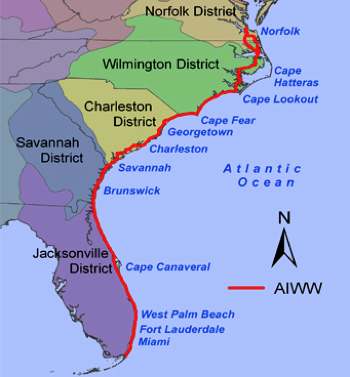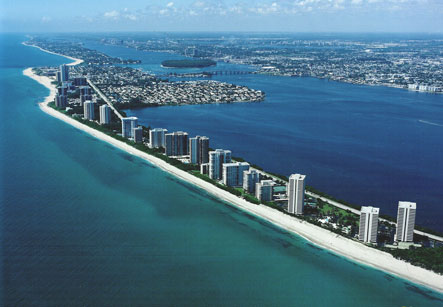Discover Florida Nature
It's time to explore the natural Florida


|
|
|
|
|
 The Cross Florida Barge
Canal was a canal project to connect the Gulf of Mexico and the Atlantic
Ocean across Florida for barge traffic. Two sections were built but the
project was cancelled, mainly for environmental reasons. It is now a
protected green belt corridor, one mile wide in most places. Named
after the leader in the opposition against the canal, Marjorie Harris
Carr, it is known as the Marjorie Harris Carr Cross Florida Greenway. The Cross Florida Barge
Canal was a canal project to connect the Gulf of Mexico and the Atlantic
Ocean across Florida for barge traffic. Two sections were built but the
project was cancelled, mainly for environmental reasons. It is now a
protected green belt corridor, one mile wide in most places. Named
after the leader in the opposition against the canal, Marjorie Harris
Carr, it is known as the Marjorie Harris Carr Cross Florida Greenway.
The planned route of the canal followed the St. Johns River from the Atlantic coast to Palatka, the valley of the Ocklawaha River to the coastal divide, and the Withlacoochee River to the Gulf of Mexico. About 28% of the 107-mile project was built—the cross-country section from the St. Johns River to the Ocklawaha River, part of the route along the Ocklawaha, and a small section at the Gulf of Mexico end up to the dammed Lake Rousseau. All the bridges over the St. Johns River north of the canal are high enough for ships, or have movable sections. High bridges were built over the canal, as well as several over the Ocklawaha River where it was not widened to the canal. Florida's Intracoastal Waterway system runs along the Sunshine State, providing boaters with extraordinary ports of call. The Intracoastal Waterway is a 3,000-mile waterway along the Atlantic and Gulf coasts of the United States. Some lengths consist of natural inlets, salt-water rivers, bays, and sounds; others are man-made canals. The Florida Intracoastal Waterway system provides a navigable route along its length without many of the hazards of travel on the open sea. The creation of the Intracoastal Waterway was authorized by the United States Congress in 1919, and is maintained by the United States Army Corps of Engineers. The waterway consists of two non-contiguous segments: the Gulf Intracoastal Waterway, extending from Brownsville, Texas to Carrabelle, Florida, and the Atlantic Intracoastal Waterway, extending from Key West, Florida to Norfolk, Virginia. The two segments were originally intended to be connected via the Cross Florida Barge Canal across northern Florida, but this was never completed due to environmental concerns.  The
Intracoastal Waterway has a good deal of commercial activity; barges
haul petroleum, petroleum products, foodstuffs, building materials, and
manufactured goods. It is also used extensively by recreational boaters.
On the east coast, some of the traffic in fall and spring is by
snowbirds who regularly move south in winter and north in summer. The
waterway is also used when the ocean is too rough to travel on. Numerous
inlets connect the Atlantic and the Gulf of Mexico with the Intracoastal
Waterway. The Intracoastal Waterway from Fort Myers to Longboat Key is a
favorite destination for visiting sailors and fishermen alike. The
Intracoastal Waterway has a good deal of commercial activity; barges
haul petroleum, petroleum products, foodstuffs, building materials, and
manufactured goods. It is also used extensively by recreational boaters.
On the east coast, some of the traffic in fall and spring is by
snowbirds who regularly move south in winter and north in summer. The
waterway is also used when the ocean is too rough to travel on. Numerous
inlets connect the Atlantic and the Gulf of Mexico with the Intracoastal
Waterway. The Intracoastal Waterway from Fort Myers to Longboat Key is a
favorite destination for visiting sailors and fishermen alike. The waters from Fort Myers through Pine Island Sound and Charlotte Harbor have to be one of the most diverse boating and fishing locations anywhere in the world. Pine Island Sound is bounded on the west by Sanibel, Captiva and North Captiva Islands. Hundreds of islands dot the Sound; redfish, snook, pompano and speckled trout delight the patient angler. To the east, Pine Island's mangrove shorelines, tidal creeks and oyster bars still resist the crush of development. Explore Matlacha, Pineland and Bokeelia for a taste of the real Florida, where Calusa Indians farmed and fished 1,000 years ago. Further north in Charlotte Harbor sits Cayo Costa State Park, a spectacular wild and scenic gulf coast island accessible only by boat. Nature trails, safe harbors, cabins, tent sites, hiking and biking trails and miles of deserted beaches make this a must-see location. The Intracoastal runs along the eastern shore of Cayo Costa before heading inland at Boca Grande Pass, "Tarpon Capital of the World." At the southern end of this section of the Intracoastal sailors pass through Card Sound before reaching Key Largo, the first island in the famous Florida Keys chain. The largest of the Keys, Key Largo is famous for its diving and fishing. John Pennekamp Coral Reef State Park, the nation's first underwater park, is the crown jewel of the area. |
|
|
Advertise | Privacy Statement | Dog Encyclopedia | Video |Contact | Alaska Nature |
|